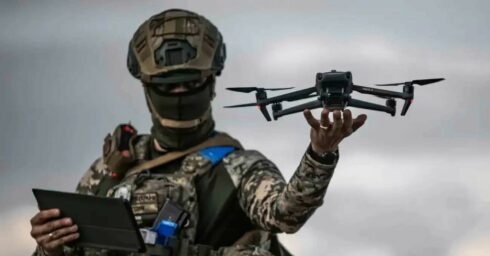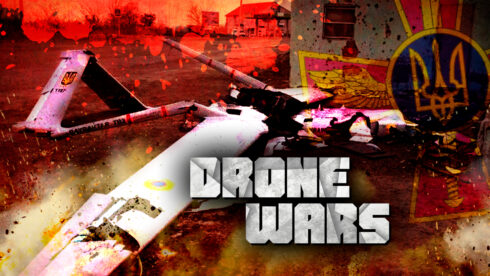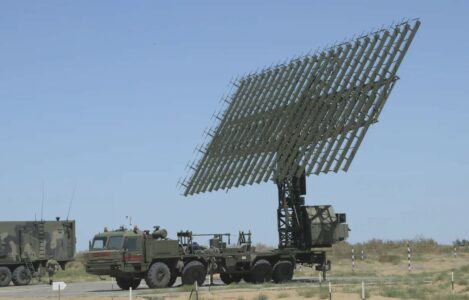Facing severe manpower shortages, dwindling artillery supplies, and uncertain Western military aid, Ukraine has turned to an ambitious technological solution called the “Drone Line” project. This initiative seeks to establish a 50-kilometer-deep “kill zone” along the front lines, where swarms of tactical reconnaissance and attack drones would dominate the battlefield, making Russian advances prohibitively costly. The concept reflects Ukraine’s broader shift toward asymmetric warfare, leveraging cheap, mass-produced drones to compensate for its disadvantages in conventional firepower.
While the Ukrainian military may only gain dominance in low skies in some directions, Kyiv obviously makes a bet on small UAVs. The project aims to freeze the conflict into a static, attrition struggle, reminiscent of World War I trench warfare, but with unmanned systems replacing human waves. However, while the idea is innovative, its execution faces tremendous challenges, from Russian electronic warfare to logistical constraints.
Ukraine’s “Drone Line” project represents a technological and asymmetric response to Kyiv’s chronic manpower shortages and conventional military disadvantages. Faced with an adversary it cannot defeat through traditional means, Ukraine seeks to transform the conflict into a static, trench-based stalemate dominated by drones. This approach reflects a pragmatic adaptation to failed mobilization efforts and severe deficits in artillery ammunition and air support.
By merging hierarchical military structures with decentralized, networked drone operations, Ukraine aims to create a hybrid warfare system capable of inflicting disproportionate losses on Russian troops. The Drone Line concept, prioritizing layered surveillance and precision strikes across different depth zones, emerges as the most logical solution given Ukraine’s resource constraints. While not without implementation challenges, this initiative may demonstrate Kyiv’s ability to innovate under pressure, leveraging cost-effective drone technology to compensate for its material and numerical inferiority. The project’s ultimate success will depend on overcoming Russian countermeasures and maintaining sufficient operational scale along the extensive frontline. Nevertheless, it signifies a potentially transformative development in modern warfare, where asymmetric technological solutions may redefine the dynamics of force projection and territorial defense.
The Concept: Layered Drone Dominance
Ukraine’s ambitious “Drone Line” project, launched in January 2025 after two previous attempts, represents a strategic initiative to create a comprehensive unmanned defense system along the frontline. The system integrates reconnaissance, strike, and electronic warfare drones into a cohesive operational framework, where scout drones immediately relay target coordinates to attack drones while being protected by EW support. This approach seeks to transform previously fragmented FPV drone operations into a centralized, synergistic system capable of slowing Russian advances.
The 50-kilometer kill zone is planned to be structured in depth, with each layer serving a distinct tactical purpose. The immediate 0–5 km sector is designed as a “scorched earth” area, where everything is mined and all constructions are demolished to prevent Russian infantry from any cover. Reconnaissance drones and FPV kamikaze units ensure no enemy infantry or light vehicles can establish a foothold. Beyond this, the 5–15 km belt focuses on logistics interdiction, targeting supply convoys, repair depots, and ammunition dumps to cripple Russia’s ability to sustain assaults. Further back, the 15–20 km sector is reserved for artillery suppression, where Ukrainian drones hunt down Russian howitzers, MLRS, and self-propelled guns. Finally, the 20–50 km zone is dedicated to strategic disruption, striking command posts, air defense systems, and rear bases to degrade Russia’s operational capabilities.
According to NY Times reports, the initiative plans to establish four specialized battalions totaling 10,000 drone operators. The program currently incorporates the most famous drone units including “Birds of Madyar,” “Rarog,” “Achilles,” “Phoenix,” and “K-2,” which have received substantial budgetary allocations ranging from 4 to 6 billion UAH per unit. These resources are being directed towards personnel recruitment, ammunition supply, and prioritized access to pilot training centers.
However, after three months of active implementation, most components remain unrealized, with full operational capability projected for late 2025. The project faces significant organizational and technical challenges in creating this complex, integrated drone network across the entire frontline. While promising in theory, its practical effectiveness will depend on overcoming coordination hurdles and maintaining sufficient operational tempo against Russian countermeasures. After three months of active attempts of implementation, much of the project remains theoretical. Sources admit that the “Drone Line” has yet to reach its full potential.
While presented as an innovative phase in drone warfare, the initiative essentially seeks to formalize and centralize existing asymmetric warfare capabilities. The emphasis appears to be on creating an organized structure for drone operations rather than developing fundamentally new technologies or tactics.
Defensive Tactics and Innovations
Ukraine’s current military strategy is primarily defensive, aimed at halting Russian advances rather than launching large-scale counteroffensives. The Ukrainian military admits it won’t be going on another bloody offensive, so as Kyiv wants to create a kill zone to destroy everything and prevent the enemy from hideouts the desperate Ukrainian soldier no longer need.
Former Ukrainian Commander-in-Chief Valerii Zaluzhnyi emphasized that drones have changed the nature of warfare. At the UK-Ukraine Defence Industries Forum in London, he noted that the conflict has already allegedly reached a stalemate, with deep maneuvers and operational strikes nearly impossible due to the saturation of drones on the front lines. However, the Ukrainian military is yet to stop Russian advance in the Donbass.
Drones have become the dominant Ukrainian force on the battlefield, accounting for about 70% of casualties in the war. FPV drones are cheap, and Ukraine faces no shortages of necessary Chinese-made components. Recruiting drone operators is also easier than finding infantry soldiers.
The Drone Line project is one of key elements of this Kyiv’s approach aimed at completely stopping the enemy’s advance.
Another initiation mainly dedicated to drone operators aimed at facilitating military logistics was the launch of Brave1 Market—a digital marketplace where military units can order equipment directly via an app. It mirrors civilian e-commerce platforms. The project reportedly offers over 1,000 items, including FPV drones, ground robots, electronic warfare modules, and ammunition. The Ministry of Digital Transformation covers the costs, while the military handles delivery. This system should eliminate bureaucratic delays, allowing troops to get what they need quickly and efficiently.
In an attempt to motivate soldiers and attract the youth to the war, Ukraine has also introduced a gamified reward system called Army of Drones Bonus, where units earn points for destroying enemy targets. For example, 20 points for a damaged Russian tank, 40 points for a destroyed one, 6 points per eliminated soldier etc. The gained points can be exchanged for military equipment. The system fosters competition among units and incentives efficiency, with the Ukrainian Defense Ministry reporting high satisfaction with the results. It also allows to identify the most effective units, like the notorious Ptakhy Madyara, which are then invited to the Drone Line project.
Ukraine’s much-touted Drone Line initiative has encountered crippling setbacks, exposing fundamental flaws in its conception and execution. Designed to offset Kyiv’s artillery and manpower shortages, the project instead highlights Ukraine’s inability to sustain large-scale technological warfare against Russia’s adaptive tactics.
Vulnerable Infrastructure, Resource Shortages and Industrial Limitations
At its core, the Drone Line suffers from insurmountable resource constraints. Ukraine lacks the industrial capacity, funding, and personnel to deploy a continuous drone grid across hundreds of kilometers of active frontline. While Kyiv has decentralized production to small workshops to evade Russian strikes, these scattered facilities are highly vulnerable to targeted attacks even in rear regions. Constant Russian strikes are systematically dismantling drone assembly hubs, further straining Ukraine’s already depleted stocks.
Compounding the issue, severe manpower shortages force Ukraine to prioritize drone operators for high-casualty frontal assaults rather than defensive operations. This leaves critical gaps in drone coverage, undermining the very premise of a seamless “line.”
A functional drone network requires secure communications, relay stations, and stable power supplies, all of which are prime targets for Russian devastating strikes, including with upgraded heavy FAB bombs.
The result is a patchwork of disjointed drone operations, where units often fire blindly into contested zones with little coordination.
Strategic Inflexibility and Russian Countermeasures
The Drone Line’s fatal flaw is its static nature. Designed for stable frontlines, it collapses under dynamic Russian maneuvers. Russian breakthroughs in different directions demonstrate how rapid advances render pre-positioned drone grids obsolete.
The global advancement of unmanned technologies has triggered an intense arms race between drones and electronic warfare systems. Should Ukraine successfully implement its ambitious Drone Line project, breaching this defensive system would require a massive deployment of electronic warfare (EW), signals intelligence, and radar reconnaissance assets by the advancing Russian military.
According to Russian military experts, to effectively suppress Ukrainian drones operating across a broad frequency spectrum from 100 MHz to 6 GHz, an estimated 120 EW systems would be necessary, each capable of jamming signals within a 1.5 km radius. This electronic shield would need to be complemented by 22 radar reconnaissance systems for detecting drone signals at 5-7 km distances and 12 signals intelligence systems for precise target tracking at 10-15 km ranges. The operation would also demand about 880 trained personnel to maintain and operate this sophisticated network.
While this represents only part of the necessary equipment for frontline units, implementing even this basic configuration could render Ukraine’s planned 50 km “kill zone” ineffective, potentially collapsing the entire defensive strategy. The outcome of this technological confrontation will be determined by which side can innovate and implement solutions more rapidly in this ever-evolving battlefield.
Kyiv’s hope of “saturating” the front with drones to halt Russian advances is faltering. Even in optimal conditions, drone attrition rates outpace Ukraine’s ability to replace losses. Russian tactics, such as layered air defenses, EW dominance, and counter-drone operations, have turned supposed “drone swarms” into costly, low-impact sorties.
The Drone Line was never a war-winning strategy but a desperate stopgap to mask Ukraine’s artillery and manpower crisis. While it may slow Russian advances in localized sectors, the project’s logistical fragility, resource depletion, and tactical rigidity ensure it cannot reverse Moscow’s momentum.
As Russia continues to degrade Ukraine’s drone capabilities through devastating rear strikes and battlefield adaptations, the Drone Line risks becoming another failed techno-optimist experiment, one that consumes scarce resources from the West without delivering decisive results. The initiative’s collapse underscores a broader truth: no amount of improvisation can compensate for structural deficits in a war of attrition.









the only asymetrical mesure ukraine has is terrorism. that what happens when 50 countries go all in but are defeated in a war they themselves provoked and their hubris doesn’t alllow them to backtrack.
security chaos | general security forces assault judge in aleppo
on may 25, 2025
share
aleppo province: general security forces of aleppo university severely beat an investigative judge in aleppo, while he was carrying out his official duties inspecting a crime scene within his judicial jurisdiction.
according to reliable sohr sources, the judge was detained by the security members for 24 hours, before releasing him in critical condition due to the severe beating.
the russian sheeps love an ice cream with the forehead
with nato on the ground russian invaders would be at moscow already but russian govern still have arses as anyone
if you paid for the english lessons, you got ripped off.
according to reliable sohr sources, judges refrained from holding court sessions today and raised their voices in solidarity with their colleague, a rare scene within official judicial institutions.
meanwhile, members affiliated with the general security forces intervened, sending heavily armed patrols into the justice palace in an attempt to break up the sit-in and end the protest.
this comes in light of growing tensions between the executive and judicial branches, amid rep
growing tension | judges and lawyers stage sit-in protest inside justice palace in aleppo
on may 26, 2025
share
aleppo province: sohr sources have reported that judges and lawyers at the justice palace in aleppo suspended their judicial work and staged a sit-in inside the building, in protest against what they described as an “insult” directed at judge “ahmad haskal” while he was performing his duties.
then the endgame can be that rf starts a scorched earth strategy as well with 900+ bombers and no birds will fly🪶🪶
this comes in light of growing tensions between the executive and judicial branches, amid repeated accusations of security services interfering in judicial affairs, further deepening the crisis of trust within the country’s justice system.
you got cheated by your geographic teachers as well: syria is not russia. and the earth is not flat. you should try to get your money back! [rolling on the floor with laughter]
afu going after putin & moscow…heeeheheheehehhh
when he was a child, this guy dreamt of becoming a very very mild annoyance on a small website. such dedication for someone with such small genitals.
amid appeals to disclose his fate | sheikh saleh mansour kidnapped in jableh countryside
sheikh saleh mansour, a prominent religious character of the alawite community, was kidnapped yesterday evening from his house in ras al-ain village in jableh countryside by members of a patrol of auxiliary forces to the ministries of defence and interior.
wake up you’re dreaming.
according to sohr sources, the auxiliary forces stormed the house of sheikh saleh at 07:00 pm, verbally abused his wife and minor children and took him at gunpoint. the forces also attempted to stole the man’s car and kidnap other members of his family, but several people from the village interfered and prevented them from doing so.
yesterday, sohr sources reported that general security forces of aleppo university severely beat an investigative judge in aleppo, while he was carrying out his official duties inspecting a crime scene within his judicial jurisdiction.
according to reliable sohr sources, the judge was detained by the security members for 24 hours, before releasing him in critical condition due to the severe beating.
in theory, the ukrainians could fix some issues by pulling back and shortening their front line, which would require fewer drones and make supply lines a lot shorter. i think the difficulty is that ultimately russia has an edge in logistics, industrial capacity, numbers, and stand off weapons.
pulling back will not get them very far, it will cause them to route and collapse. they dont have layered indept defensive lines to fall back upon in many areas. its often a one layer line.
that is why they hang on to some of their fortified positions as long as possible. because new defensive line have to be build before the front one is allowed to collapse. they have wasted thens of thousands of men that way.
the family of sheikh saleh mansour have called for disclosing his fate immediately, ensuring his physical and psychological safety and holding accountable every person involving in the attack on his house and his family, as they see that action as a blatant human rights violation
more ‘wunderwaffe’ coming from merz the king of schmalz.
threatening civil peace | prominent alawite sheikh kidnapped in tartus
on may 24, 2025
tartus province: sheikh saleh saud, the deputy imam of the ali ibn abi talib mosque in al-jami‘e neighborhood in tartus, was kidnapped, while the abductor accusing a local media figure in tartus of luring him and handing him over to the local authorities. meanwhile, residents have pointed fingers at an individual identified as (m.z) from al-baraniyah village.
what, two sheikhs slaughtered in one month? isn’t that a world record?
this coincides with growing concerns among residents in the syrian coast over increasing violations committed by auxiliary forces to the ministries of defence and interior against people of the alawite community in light of the complete absence of accountability and deterrence.
a plane spraying a kind of glue creating a sticky rain forcing drones to land or crash. birds of prey trained to attack recon drones. who knows ?
according to reliable sohr sources, no summons had been issued against sheikh saud, nor was he in hiding at the time.
sheikh saleh saud is known for belonging to the alawite sect and for his active role in promoting civil peace and fostering dialogue among the various religious and social communities in tartus province. a committed religious scholar, he holds a degree in islamic studies.
and what is islamic studies? a camel driving test?
no, diplomas in smoking camel cigarettes, like you do through your arse.
midget vlad thought trump was going to save him…heheheh
trump and the eu thought they could outsmart the russians and failed. now, the us will try to pivot against china and will lose, as usual. but this time the consequences will be catastrophic for the west. no coming back from that.
any legal justification or formal decision from the relevant authorities.
the syrian observatory for human rights affirms that such actions do not contribute to societal stability and instead pose a direct threat to efforts aimed at promoting civil peace and fostering harmony among the region’s diverse religious and social groups.
is it a human right to slaughter infidels? even in bangladesh, islamists are hunting down and killing infidels. it’s like the inquisition in spain. why didn’t they leave this in the past? why didn’t they ban religion and monotheism, because monotheism is the root cause of all massacres and violence?
his detention has sparked a wave of outrage among local and religious communities, with widespread calls to condemn undisciplined actions and reject any retaliatory practices carried out outside the framework of the law.
religious and social entities in tartus province have strongly denounced these individual, unlawful acts, most recently the detention of sheikh saleh saud, deputy imam of the ali ibn abi talib mosque, which occurred without
i hope merz declares war on russia.
those drones are only temporarily effective until more effective anti drone electric warfare devices are inplemented. even if its a drone with a long wire it can still be neutralized with the right equipment that will fry its electronics.
the reason they were effective early on was because the air defense was more tuned towards shooting down planes with anti air craft guns and large long range missiles. trying to shoot down a very small agile target is not as effective that way even with rapid fire aa guns.
now more effective weapons are developed and they will fill the ranks making alot of those drones much less effective.
think of them like flies buzzing around your head a fly that flies away is harder to swat. but if you have an electrified racket you will swat it from the air by electrocuting it. those drones can be disabled effectively if you have radars that are tuned to spot them and electric warfare devices that can disable and fry its electronics. and jam signals. even small arms can also be effective.
my suggestion is atleast a pair of soldiers armed with shotguns for each veichle. no need to be bottomed-up with ‘casemate tanks’ and similar horrors. just let came them and shot them down.
this will, however, not be a one or few step process, but instead just another arms race with both offensive and defensive measures. it will never become drastically asymmetric, because you can’t completely suppress technology exchange while having it operated by huge human forces.
a high altitude nuke will do that with its hemp. someone will have to explain to trump though that it’s something that smokes you, not that you smoke.
it seems the negations are not working for the nato mafia . russias demand of complete demilitarization must have war mongers in panic . trumps war continues .
derp derp.
fpv drones vs fab-3000: who will win?
ahahahahaha. good one.
the lie:”ukraine’s drone line: strategic gambit in asymmetric warfare”…
the truth: nato$tan’s drone line strategic gambit in asymmetric warfare”…
destroying russia has clearly become a neurosis, although the west may be hoping for a replay of their – mistaken – belief that inducing the ussr to intervene in afghanistan ultimately disintegrated it. but then, western media is an echo-chamber resonating only militaristic views that never attempt to connect with any inconvenient reality.
i’m torn between stocking food and arms in my basement or just throwing up my arms and to hell with it, life’s short anyway.
only a few mammal species inferior to americunt—monkey–same, spiderman and ukrainian
i’m glad this article isn’t an essay i have to grade, talk about saying the exact same shite differently in the first 3 paragraphs, over and over again like whipping cream to fill up space on a page. i can’t get that time back that i wasted reading this crap overly repetative article. yawn…nothing profound was revealed… just yawn!
how many babushkas does ukraine have assembling drones from pickle jar lids in their kitchens?
can we use girl math to answer this question?
with regard to the paragraph “according to russian military experts…”: this is meant per 100 km frontline. thus multiply this by the number of 100 km stretches that constitute the frontline.